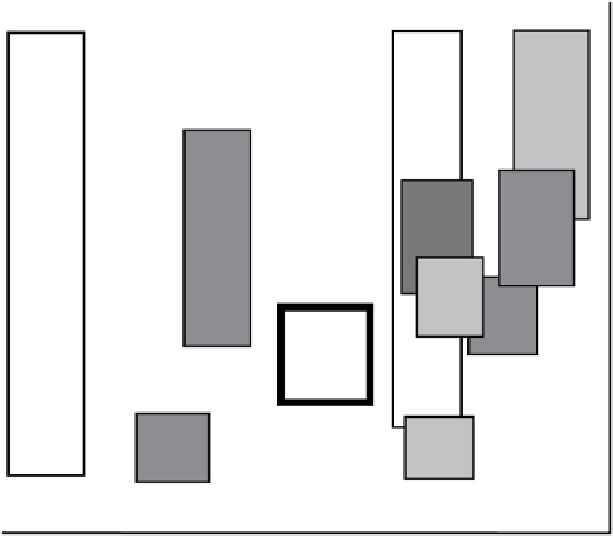Geology Reference
In-Depth Information
Digital value (V)
σ
0
-4.5
140
Wind
speed:
8 m/s
Frost
flowers
on
thin
ice
Rough
ice
and
ridges
Pancake
ice
-5.8
120
First-
year
floes
Small
∼
20 m
-7.4
4 m/s
100
Multi-
year
ice
Nilas
-9.5
Medium
∼
100 m
80
Gray
White
ice
Smooth
first-year
ice
Large
>500 m
2 m/s
-12
60
Smooth
multiyear
and
first-year
floes
-15
40
1.5 m/s
New
thin
ice
Grease
ice
-21
-25
20
<1.3 m/s
Open
ocean
Summer
Interior of pack ice
Winter
Ice edge region
Winter
0
Figure 8.4
Backscatter coefficient of ice types in the Barents Sea obtained in March 1992 during SIZEX
experiment and other SAR ice validation experiments using ERS‐1 SAR observations (C‐band, VV polarization,
and 23° incidence angle). Data are expressed in dB (left scale) and digital value (right). ERS SAR backscatter
of open water for different wind speeds is included for comparison [
Sandven et al
. 1999, Figure 11, with
permission from AGU].
from ERS‐1 C‐band SAR (Figure 8.5). New ice has high
backscatter due to its high surface salinity that makes it
more reflective. It can also be attributed to the presence
of the short‐lived frost flowers. The decrease of surface
salinity also causes an increase of microwave emission.
Dry snow on FY ice does not affect the backscatter from
snow‐covered ice during winter (remains around −15 dB
level from FY ice). However, snow may reduce it tangibly
when it becomes wet or metamorphosed.
The backscatter from MY ice data in the early period
of the freeze‐up season is relatively low (−15 dB) as shown
in Figure 8.5. This is probably caused by wet surface. As
the cold winter approaches it increases to values ≥ −10 dB
and remains stable throughout the winter and early
spring. This relatively high value is triggered mainly by
volume scattering caused by air bubbles in the subsurface
layer of hummock ice. The melt onset is marked by a
rapid increase in
σ
0
from FY ice as the wet snow becomes
more reflective of the microwave energy. At the same time
a sharp decrease of
σ
0
from MY ice is caused by the reduc-
tion of volume scattering as a result of the gradual
removal of the bubble‐rich layer of the ice when surface
melt starts. During the advanced melt period, a rather
sharp increase in
σ
0
from MY ice is caused by the disap-
pearance of the wet snow (lossy medium). Backscatter
from FY ice continues to increase during this period
and overlap with
σ
0
from MY ice. The increase is
attributed to the ponding period (with low albedo) as
shown in Figure 7.42. Backscatter from FY ice decreases
again as the surface flood begins to drain [
Yackel and
Barber
, 2000].
The operational Radarsat image analysis at the
Canadian Ice Service (CIS) of Environment Canada pro-
vides a good source for extracting backscatter signatures
of ice types. The information about ice types and their
concentrations are provided within delineated polygons
in analyzed Radarsat images. A trained analyst examines
the image visually and delineates a number of polygons.
Each polygon, called image analysis polygon (IAP),
encloses homogeneous distribution of up to three ice
types as suggested by the analyst. Ice types and concen-
trations are assigned subjectively to each polygon.
Procedures of Radarsat image analysis, including gen-
eration of IAPs and production of operational daily ice
charts are described in Section 11.2. This information
can be used to compile a backscatter database from ice
types. There are thousands of analysis polygons availa-
ble in each region because CIS analyzes approximately
1100 Radarsat images annually to produce the daily
composite ice charts. Most of the IAPs, however, are






















